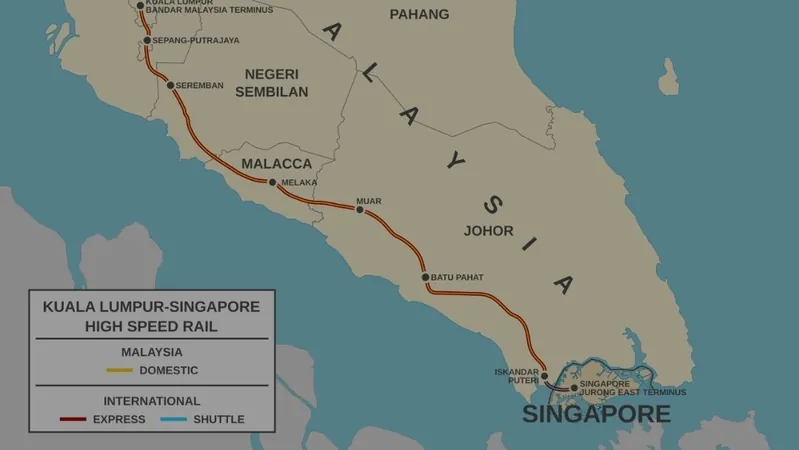
Major Shake-Up in High-Speed Rail Project as MRCB Withdraws – What It Means for Regional Connectivity!
2025-01-02
Author: Wei
Major Shake-Up in High-Speed Rail Project as MRCB Withdraws
In a surprising move that has sent ripples through the infrastructure sector, Malaysian Resources Corporation Bhd (MRCB) has officially withdrawn from the Kuala Lumpur-Singapore high-speed rail (HSR) project. This decision underscores the company's commitment to financial prudence as economic uncertainties loom large, particularly for large-scale projects that come with substantial financial risks.
Industry analysts interpret MRCB’s exit not as a defeat but rather as a strategic retreat aimed at safeguarding long-term shareholder interests while focusing on sustainable growth. The ambitious HSR initiative, which initially promised to enhance regional connectivity, is no stranger to setbacks since it was first proposed in 2013. Delays caused by political upheavals and changes in government priorities have plagued the project, including its suspension under the Pakatan Harapan government in 2018.
While the HSR remains a long-term goal for both Malaysia and Singapore, the challenges clearly outweigh the rewards at this juncture. MRCB's departure from the consortium previously led by Berjaya Group opens the door for competing firms, with YTL Construction and SIPP Rail reportedly positioning themselves as strong contenders for the development contract.
Analysts believe MRCB's withdrawal is a well-calculated risk management decision, aimed at insulating the company and its stakeholders—from giants like the Employees Provident Fund to Retirement Fund Inc (KWAP)—against potential losses inherent in such a voluminous venture. Infrastructure projects like the HSR demand massive initial investment and long-term commitment, and with multiple delays, the risk exposure is unnervingly high. MRCB’s strategic pullback is a move to stabilize its financial standing and that of its investors.
However, MRCB's exit does not necessarily mean it's saying goodbye to the HSR project altogether. Experts speculate that MRCB might explore downstream opportunities in the broader transportation ecosystem, eyeing roles in property management, retail operations, and transit-oriented development (TOD) as the project progresses towards more stable operational phases.
MRCB has a track record of success in TOD, notably at Kuala Lumpur Sentral, Malaysia’s largest transit hub, showcasing its ability to interlink urban development with transit systems effectively. This expertise positions the company as a valuable player in any future collaborations concerning Malaysia's transportation infrastructure.
Originally, the HSR project aimed for a 2026 completion and was designed to connect pivotal cities across Malaysia, including Putrajaya, Negeri Sembilan, Melaka, and Johor. Unfortunately, the changing political and economic landscape led to a gradual halt and eventual cancellation of the project in 2018, with Malaysia compensating Singapore S$102.8 million for initial expenditures before the project's abrupt end.
Following MRCB's formal withdrawal, the remaining consortium—comprised of Berjaya Rail Sdn Bhd, Keretapi Tanah Melayu Bhd, IJM Corp Bhd, Deutsche Bahn, Hitachi Rail, and Hyundai Rotem—now continues to seek development opportunities while carefully navigating the complex risks and uncertainties surrounding the HSR initiative.
In the realm of infrastructure development, MRCB's exit serves as a striking reminder of the delicate balance between ambition and risk management—hallmarks of any large-scale project. What does this mean for the future of the Kuala Lumpur-Singapore high-speed rail? Only time will tell, but one thing is clear: the road ahead will be anything but straightforward! Stay tuned for more updates as this story unfolds.


 Brasil (PT)
Brasil (PT)
 Canada (EN)
Canada (EN)
 Chile (ES)
Chile (ES)
 Česko (CS)
Česko (CS)
 대한민국 (KO)
대한민국 (KO)
 España (ES)
España (ES)
 France (FR)
France (FR)
 Hong Kong (EN)
Hong Kong (EN)
 Italia (IT)
Italia (IT)
 日本 (JA)
日本 (JA)
 Magyarország (HU)
Magyarország (HU)
 Norge (NO)
Norge (NO)
 Polska (PL)
Polska (PL)
 Schweiz (DE)
Schweiz (DE)
 Singapore (EN)
Singapore (EN)
 Sverige (SV)
Sverige (SV)
 Suomi (FI)
Suomi (FI)
 Türkiye (TR)
Türkiye (TR)
 الإمارات العربية المتحدة (AR)
الإمارات العربية المتحدة (AR)